By Jeffrey A. Rendall, Photos By Jeffrey A. Rendall
WILLIAMSBURG, VA -- Water, water, everywhere. Most of the time, having water surrounding you isn't a bad thing. After all, folks pay large sums to live near the ocean, sail on a cruise ship or kayak down a raging whitewater river -- just for the opportunity to have a wet breeze blow through their hair. Water's also essential for life itself -- we may have skin, flesh and bones, but water is largely what we're made of.
Well, maybe that's stretching it a bit. But the wet stuff's quality not only adds challenge, but aesthetic beauty to a property. And that's exactly why the Blackheath course at Ford's Colony is so picturesque -- because water's such a big part of the layout.
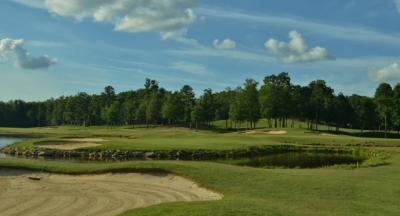 |
| The approach to the 18th green is one of several where you'll have to clear water to get home. |
Scientists tell us that life can't exist without water -- and the first thing they look for whenever one of our space probes hits the atmosphere of some distant world is whether the planet has H2O. If there isn't any water, we can't sustain ourselves there without bringing it with us. Water's a heavy load -- but water's life.
It's also a major component of the game of golf -- water's the one hazard you can't play out of, even if you can find the ball (as Jean Van de Velde discovered at Carnoustie). Golf architects put it on their courses to make us think about shaping shots -- challenge the water and you'll either triumph or perish. Just as the ancient Mariners took on the sea, a golfer takes on a lake, pond or stream.
Water is found on thirteen of Blackheath's holes, and comes prominently into play on most of those. There's a sizeable reservoir that bisects the course, and a good portion of the holes are cleverly fitted around it.
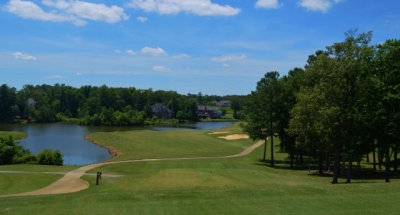 |
| Right from the start, you will see a tee shot framed by water. Here, the par five 1st hole. |
Architect Dan Maples did an outstanding job of placing Blackheath aside the lake (and several other bodies of water) without making it overbearing or unfair.
In fact, Ford's Colony's Head Golf Professional, Richard Rice, says Blackheath's probably the easiest of his three courses to score well on, despite the high water volume. "Blackheath's really a great course because it's got a lot of water on it, but chances are you won't find it unless you really hit one badly. Because there are so many prominent water hazards -- you'll probably feel as though you've played a good game if you've scored well and managed to avoid most if not all of the lakes. For that reason, it's a very popular course."
Rice continues, "But the water can work itself into the picture if the wind's blowing. We've got some holes out there facing every which direction, so chances are you'll be into the wind at some point. Right about then, the water'll be all you want."
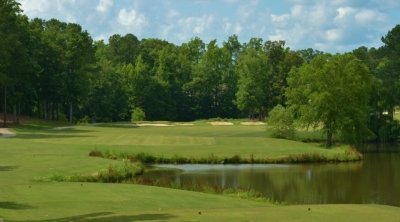 |
| The fifth tee's elevation will give you a better chance to avoid the water, yet if you have one bit of slice on the ball, you're in trouble. |
Blackheath, like its sister course, Blue Heron, is actually the amalgamation of one of Ford's Colony's newest nines and the older Gold nine that opened in 1991 (they were combined in the late 90's).
With the completion of the newest 18 holes, Blackheath took nine of them, the Red and White nines became the Marsh Hawk course, and Blue Heron combined the older Blue (completed in 1987) nine with the final set of nine holes.
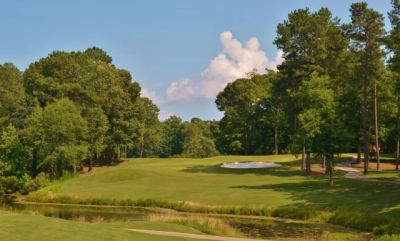 |
| The 183 yard 8th hole features only a mild water carry, yet if you're in the bunker on the right side, it's a very tough up and down. |
Sound confusing?
It's not once you're on the property. Blackheath's eighteen blends together so well, it's amazing to think it wasn't all there in the first place. As adequately noted before, it's got a good share more water than the other two courses, but it's also much more open. The closing sequence -- sixteen, seventeen and eighteen play alongside the lake in what Rice calls the "Valley of Golf."
It's a fitting label, because it really looks very natural -- like the holes were there all along.
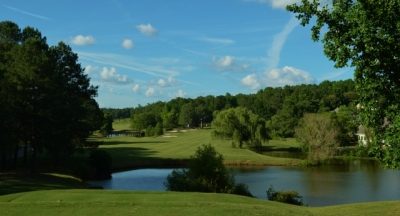 |
| Entering the 'Valley of Golf,' the 16th tee will challenge you once again with a hefty water carry. |
And because Blackheath has so much water, I'd say it's less undulating than the other courses. Fewer ups and downs means visibility is excellent on most holes. That's important, for more than just beauty alone.
Dan Maples, who designed all 54 holes at Ford's Colony, says ensuring visibility on the golf course is one of his primary goals. "My Dad (Ellis) was fortunate during his younger years to study under Donald Ross at Pinehurst. Ross was always tweaking the #2 course, and the majority of what he did was to take out blind shots."
"We always work extremely hard when designing a course to take out as many blind shots as possible, for a number of reasons -- first and foremost because they're unsafe. I personally don't like it when you can't see your ball land, so if there's a stretch of ground where it's possible to see a landing area, I'll work to include it. I'm not saying it's always possible, but we'll do it if there's an opportunity," said Maples.
Needless to say, Maples achieved his aim on Blackheath -- actually all three of Ford's Colony's courses. He said the primary challenge in creating the different Ford's Colony layouts was working with the varied terrain the property presented -- but he's done well to craft three complete layouts that aren't carbon copies of each other.
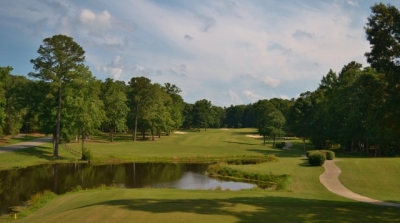 |
| The view from the tenth tee shows you exactly what you have to do -- no blind shots on a Dan Maples designed course. |
Rice even goes so far as to say that no two holes are alike in the entire complex. How's that for variety?
Another distinguishing characteristic of the Blackheath layout are the greens. They're fairly large and not overly undulating. It'll present more opportunities to score more greens in regulation, and make some putts once you get there.
In other words, if you avoid the water, you can get those good scores Rice talked about. The tee landing areas are generous, and you won't find the trees encroaching on the fairways as much as you will on the other layouts.
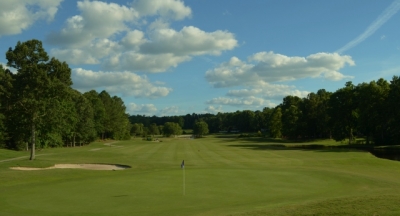 |
| From behind the 17th green, you'll grasp the wide-open nature of Blackheath's 'Valley of Golf.' |
Turning to the course, #1 greets you with a tough link right off the bat. It's a 540 yard (from the back tees) par five that doglegs to the right. Tee shots are to a very wide fairway, but water lurks long and left. A bunker guards against cutting the corner. You'll most likely have to lay up with your second -- even then it's a tough call to go away from the water all down the left side.
The second hole is actually bone dry!
But you'll get back to the water on three in a big way. It's a 187 yards from the back sets (par three, of course) with about a 160 yard water carry that looks longer. It's not an island green, but there's water front and left. Bailout right if you want the safe route.
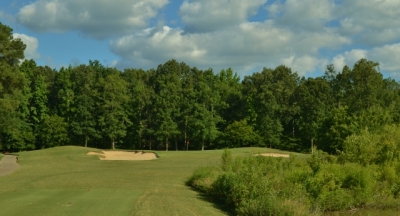 |
| There is a marshy feel to the par three 14th hole. |
Five through eleven showcase Blackheath's undulation -- again, nothing severe.
Five is a very pleasing visual par four. You'll tee from elevated boxes with water on the right this time. Plenty of room left to miss, but if you're long through the slight dogleg right, you'll find sand. The second shot's to an elevated green.
Eight's a good par three. Shooting slightly uphill over a pond in the mid part of the hole, you won't find the water unless you shank it. It's a challenging mid to long iron, playing 183 yards -- and the day we played, into the wind. There's a mowed chipping area short, so that's probably the best miss option, but this is one of the more undulating greens on the course.
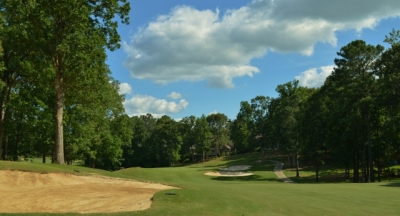 |
| The ninth hole offers one of the rare 'dry' glimpses on the Blackheath course, but it is still quite a sight.. |
Moving forward to twelve, you'll see water on every hole from here to the clubhouse.
Twelve's a 182 yard par three from an elevated tee box, again over water about three-quarters of the way to the green. Fairly easy hole, but correctly judge the wind to get it close.
Thirteen, fourteen and fifteen are grouped together on a plot of land adjacent to Blue Heron's fifteenth hole. Thirteen's a sharp dogleg left where you'll probably want to club down off the tee to place it properly for your second shot -- over water. Big surprise.
Fourteen's an aesthetically pleasing 170 yard par three. Avoid water short and wetlands to the left. Long is actually not too bad an option here, since the green's reasonably flat and the rough will provide a nice fluffy lie (if you're really lucky).
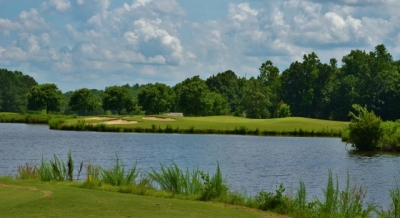 |
| Lots of water, lots of bridges on the Blackheath course. Looking at the par three 3rd hole. |
Fifteen's the toughest tee shot on the course. The day we played it was into a pretty stiff wind, and it's over 200 yards of water carry from the back tees. Rice says it's a tough carry even from the forward tees -- true, as my playing partners Kevin and Carl found out -- they each contributed two balls to the local economy on this hole.
Sixteen, seventeen and eighteen are a tremendous closing set of par fours, down through the 'Valley of Golf.' Sixteen and seventeen are reasonably straight-on, and all the challenge is on the tee ball to avoid -- water (getting redundant here). On sixteen, you'll need to avoid it short and right.
Seventeen, it's also short and right. There is some room to miss left, but down the center's the best play (isn't it always?).
Eighteen is an excellent finishing hole. Measuring just 356 yards, you'll play both shots over water. The carry from the tee looks like it rivals #15's, but I don't think it's that far. The second shot's to an island green. It's a fairly large island, though, so chances are you'll arrive dry.
It's fitting that the closing sequence on the Blackheath course is so water challenging. It really helps to 'shore' up the water theme all throughout the course. I don't think you'll get sick of seeing all the water along the way, however -- it's actually very beautiful.
But after playing Blackheath, you'll probably go straight to the travel agent to cancel your cruise reservations.
Details:
The Blackheath Course at Ford's Colony
240 Ford's Colony Drive
Williamsburg, VA 23188
Phone: (757) 258-4130
FAX: (757) 258-4168
Website: www.fordscolonycc.com
Course Designer: Dan Maples
Head Golf Professional: Richard Rice
|
Tees |
Yardage/Slope |
Rating |
|
Black |
6621/136 |
71.5 |
|
Gold |
6101/130 (men)/142 (ladies) |
68.9(m), 74.9(l) |
|
Silver |
5338/122/126 (ladies) |
66.0(m), 71.5(l) |
|
Bronze |
4523/104 (men)/112 (ladies) |
62.7(m), 66.3(l) |
Membership Information and Rates:
Ford's Colony Country Club is now under ClubCorp.
Consult the website for current rates.
Ford's Colony is also one of the nation's leading residential communities. For more information, visit FordsColony.com.
| Related Links | Comments on this article? | |
|
Maryland National Golf Club Hollow Creek Golf Club Rocky Gap Resort PB Dye Golf Club in Ijamsville Whiskey Creek Golf Club |
E-mail Jeff Rendall, Editor: jrendall@golftheunitedstates.com |











